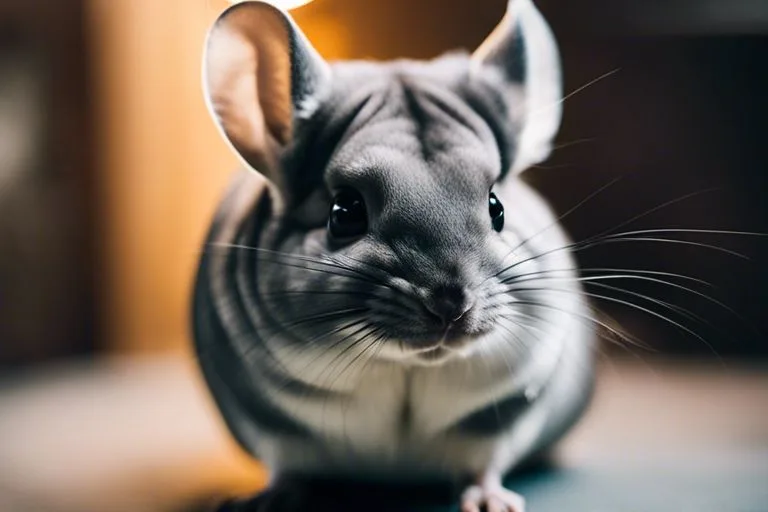Yes, chinchillas show pain through specific behaviors, including teeth grinding, a hunched posture, and changes in appetite or movement. Being prey animals, chinchillas instinctively hide signs of discomfort to avoid appearing vulnerable, so it’s essential for owners to observe them closely for subtle signs of distress.

Key Signs and Symptoms of Pain in Chinchillas
Recognizing pain in chinchillas requires understanding both physical and behavioral indicators. Here are the most common signs:
Physical Signs:
- Teeth Grinding: Unlike soft “teeth chattering,” grinding is a harsher sound that typically signals stress or discomfort.
- Hunched Posture: Chinchillas in pain often huddle, with paws tucked in, ears laid back, and the body held close to the ground.
- Drooling and Pawing at the Mouth: These signs often indicate dental pain, such as malocclusion, where teeth overgrow and cause discomfort.
- Head Tilt or Abnormal Gait: Head tilting can signal an ear infection, while limping or altered stance might indicate joint or muscle pain.
Behavioral Changes:
- Reduced Movement: A chinchilla in pain may become lethargic, avoid play, and show a general lack of enthusiasm.
- Loss of Appetite: Pain, especially in the mouth, can lead to a decrease in eating. This is often associated with malocclusion, a common dental issue in chinchillas.
- Social Withdrawal: Chinchillas are naturally social, so increased hiding or self-isolation can be a red flag.
- Refusal to Be Handled: If a chinchilla avoids being picked up or reacts aggressively, it may be trying to avoid additional discomfort.
Why Chinchillas Hide Pain
As prey animals, chinchillas instinctively conceal signs of pain to avoid attracting predators. This natural tendency makes it challenging to detect early symptoms, but by staying alert to subtle behavioral changes, you can often catch signs of pain before they become severe.
Recognizing Severe Pain Symptoms
Certain symptoms require immediate veterinary care. These include:
- Complete Refusal to Eat: If your chinchilla stops eating entirely, it could indicate severe dental pain, gastrointestinal issues, or other serious health concerns.
- Persistent Teeth Grinding: Frequent, intense grinding can signify continuous pain.
- Rapid Weight Loss and Lethargy: Significant weight loss coupled with extreme inactivity suggests critical health issues.
If any of these signs appear, seek veterinary assistance promptly, as chinchillas can deteriorate rapidly without proper care.
When to Seek Veterinary Help
Immediate veterinary help is essential when any combination of severe symptoms, such as teeth grinding, refusal to eat, or prolonged inactivity, is observed. Chinchillas are small animals, and even brief periods of untreated pain can lead to lasting health issues. A veterinarian can perform a thorough examination to identify the cause and recommend appropriate treatment.

Preventing Pain and Discomfort in Chinchillas
Ensuring a comfortable environment and appropriate care can reduce the likelihood of pain:
- Provide a Balanced Diet: Feed high-quality hay and pellets. Avoid treats like fruits or vegetables that can cause digestive issues.
- Maintain a Cool Environment: Keep temperatures below 70°F (21°C) to prevent heat stress.
- Ensure Dental Health: Provide chew toys to help prevent dental overgrowth, which can cause malocclusion and pain.
- Schedule Regular Check-Ups: Routine veterinary visits allow for early detection of health issues, ensuring timely treatment.
Daily Check-Up Routine
To keep your chinchilla healthy and pain-free, incorporate a simple daily check-up:
- Observe physical signs like hunched posture or teeth grinding.
- Check for changes in behavior, such as social withdrawal or reduced movement.
- Monitor eating habits by ensuring they consume their typical amount of food each day.
Regular observation helps you notice early symptoms, allowing you to seek veterinary care if needed.
Final Thoughts
Chinchillas, while adept at hiding pain, do show subtle signs that can alert attentive owners. By observing their physical and behavioral changes—such as teeth grinding, loss of appetite, and a hunched posture—you can detect discomfort early and seek professional help. Prioritizing preventive care, a balanced diet, and a stress-free environment enhances your chinchilla’s quality of life, ensuring they remain healthy and comfortable.
FAQ
Q: Do chinchillas show pain in a way that’s noticeable to their owners?
A: Yes, chinchillas show pain in subtle ways due to their instinct to hide vulnerability. Common signs include changes in usual habits, such as reduced activity, avoidance of interaction, or changes in grooming. Owners should watch for unusual behaviors that differ from their chinchilla’s normal routine.
Q: What are some common signs that my chinchilla may be in pain?
A: Common signs of pain in chinchillas include:
Decreased appetite
Increased aggression or irritability
Hunched posture
Vocalizations such as whining or grinding teeth
Reluctance to move or interact with people or their environment
Q: What should I do if I suspect my chinchilla is in pain?
A: Consult a veterinarian specializing in exotic pets if you suspect your chinchilla is in pain. A professional can diagnose any issues and recommend appropriate treatments. Early detection improves the likelihood of a quick recovery.
Q: How can I prevent my chinchilla from experiencing pain?
A: Preventative care is essential for keeping chinchillas healthy and pain-free. To reduce the risk of health issues:
Provide a balanced diet of high-quality hay and pellets
Create a safe environment with ample space
Maintain hygiene in their cage
Schedule regular veterinary check-ups
Observing your chinchilla’s behavior and acting quickly can prevent minor issues from becoming serious.
Q: Can chinchillas experience chronic pain, and how would I know?
A: Yes, chinchillas can experience chronic pain from conditions like arthritis or dental problems. Signs of chronic pain include persistent behavior changes, such as:
Continuous lethargy
Difficulty chewing
Consistent vocalizations that indicate discomfort
Regular veterinary evaluations are crucial for managing chronic pain and ensuring your chinchilla’s comfort.
